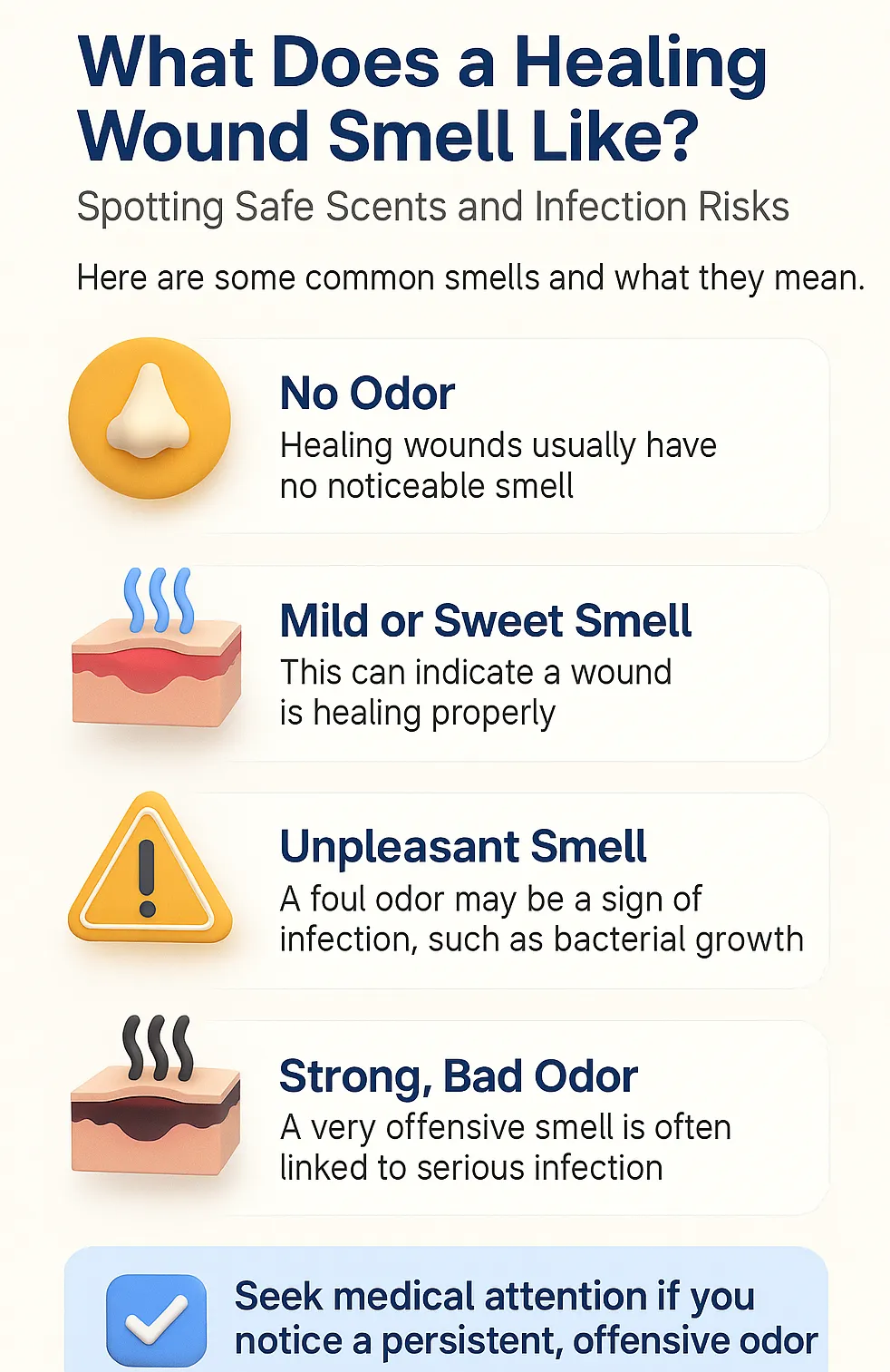If you’ve ever changed a bandage and noticed an unexpected smell, you may have asked yourself: “Is this part of normal healing, or a sign something’s wrong?” In wound care, odors are more common than many realize—and not every scent is a red flag. A faint, musty, or slightly sweet smell often reflects natural healing processes, while stronger foul odors can point toward infection.
This guide helps you understand what does a healing wound smell like, what different wound smells might mean, how they change as healing progresses, and when to take action. By learning the difference between safe healing scents and infection risks, you can approach recovery with more confidence.
Top Takeaways
- Mild musty or sweet odors are often part of normal healing
- Strong, foul, or worsening smells may indicate infection
- Changes in odor over time are more important than a single scent
- Odor should never be your only guide—watch for other warning signs like redness or swelling
- Seeking professional advice early prevents complications and speeds up recovery
Healing Wound Smells: Normal vs. Concerning
Healing wounds sometimes carry a light odor caused by moisture, dressings, or the natural breakdown of old tissue. These mild scents usually fade as the wound closes and new skin forms.
By contrast, a strong, foul, or worsening odor may be your body’s first warning sign of infection—especially when paired with pain, swelling, redness, or pus. Healthcare providers often use odor as one of the earliest indicators that a wound may need closer attention.
Recognizing the difference between harmless healing smells and infection-related odors helps you respond appropriately and protect your recovery.
First-Hand Insight
“In wound care, I’ve noticed that a faint musty odor often comes from moisture or healing tissue—not infection. But when that smell shifts to something foul and combines with swelling or pain, that’s when infection becomes a concern.”
Case Studies: When Wound Odor Matters
Normal Healing Example
- Situation: After surgery, a knee wound carried a faint musty smell
- Observation: No redness, pus, or swelling—just moisture under the bandage
- Action: Improved airflow and more frequent dressing changes
- Outcome: Odor faded as the wound closed
- Insight: Not all wound odors are dangerous—many are simply part of healing
Infection Warning Example
- Situation: A diabetic foot ulcer developed a sharp, foul odor
- Observation: Odor worsened daily, with swelling and pain
- Action: Immediate testing, antibiotics, and wound cleaning
- Outcome: Infection treated before severe complications
- Insight: Odor changes paired with other symptoms are key early warning signs
Research & Clinical Insights
- Surgical Site Infections (SSIs): Over 110,000 cases reported annually in the U.S., with odor often noted early (CDC)
- Pressure Ulcers: Affect 7.5% of nursing home residents—foul odor is often the first sign of complications (NIH)
- Diabetic Foot Ulcers: More than half become infected; odor is one of the earliest reported concerns (American Diabetes Association)
- Amputation Risk: 85% of diabetes-related amputations begin with an infected ulcer (National Library of Medicine)
Clinical takeaway: Odor alone isn’t diagnostic, but worsening odor almost always calls for a professional check.
Next Steps for Safer Healing
- Check for other symptoms: Watch for swelling, redness, heat, or pus
- Clean and protect the wound: Keep dressings fresh and the area dry to reduce bacterial growth
- Monitor changes: Mild smells that fade are often safe. Foul odors that worsen need attention
- Seek professional advice early: Don’t wait until symptoms escalate—timely care prevents complications
Final Thought
Healing wounds can sometimes smell—but not every odor is a problem. Mild, musty, or sweet scents often fade with time. What matters most is change: when odor becomes strong, foul, or comes with pain and swelling, it’s time to call a professional.
Odor is a clue, not a diagnosis. Pairing self-awareness with timely medical care and proper practices like moist wound treatment is the best way to stay safe and support healthy healing.
Frequently Asked Questions (FAQ)
Is it normal for a healing wound to have a smell?
Yes. Mild odors—like slightly musty, sweet, or earthy smells—can occur during the healing process. These usually come from moisture, dressings, or the breakdown of old tissue and often fade as healing progresses.
What kind of smell indicates an infection?
A strong, foul, or putrid odor may indicate infection, especially if paired with redness, swelling, heat, pus, or increasing pain around the wound.
Can wound odor change during recovery?
Yes. Light odors often lessen as wounds close, but if the smell worsens over time, it could be a warning sign of bacterial overgrowth or infection.
Do all infected wounds smell the same?
No. Different bacteria can cause different odors. For example, Pseudomonas infections sometimes produce a sweet or fruity smell, while other bacteria may cause a rotten or foul odor.
When should I seek medical help for wound odor?
If the odor becomes strong, continues to worsen, or is accompanied by swelling, fever, increased pain, or discharge, you should contact a healthcare provider immediately.
When asking what does a healing wound smell like? spotting safe scents and infection risks, it’s important to recognize that while mild, clean odors can be normal, foul or worsening smells may indicate infection. Just as maintaining proper hygiene around a wound prevents complications, keeping the home environment clean and free of contaminants also supports recovery. Services like Dryer Vent Cleaning in Verona Walk, FL remove hidden buildup that could contribute to poor air quality, while advanced solutions such as UV Light Installation Pembroke Pines FL help reduce bacteria and pathogens in the air. High-efficiency filters like the 12x20x1 Pleated Furnace Filters or the 8x14x1 MERV 8 Pleated HVAC AC Furnace Air Filters (2-Pack) trap allergens and microbes that could interfere with healing. Even affordable options like the HVAC Filter listing on eBay provide practical support for maintaining a healthier space. By pairing awareness of wound odors with clean indoor air strategies, patients can better distinguish safe healing from infection risks.







